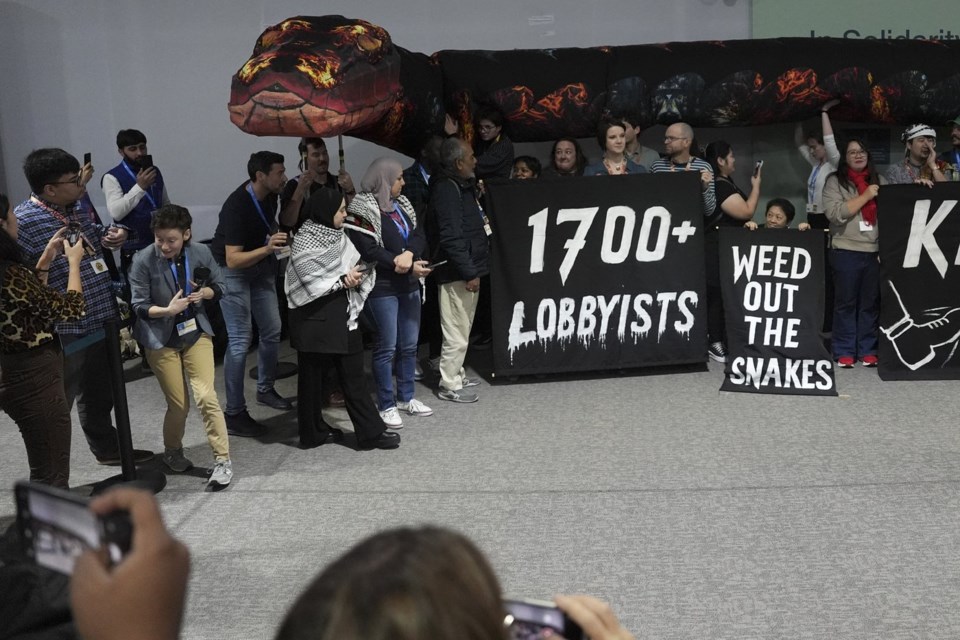BAKU, Azerbaijan (AP) — In the nosebleed seats of a nearly-empty Baku Olympic stadium coated with a layer of dust, activists used a giant banner to beam the words “Pay Up” to the world.
The protest took weeks of thought and planning, but most of the attendees at this year's UN climate talks didn't see or hear it — except for maybe some in the COP29 presidency offices right below. The majority of the people involved in deciding the financial future of climate action at the talks remained in the sprawling venue, under white tarps with no windows.
It’s “really hard to make our demands heard,” said Bianca Castro, a climate activist from Portugal. She’s been to several COPs in the past and remembers years when there were thousands of protestors in the streets, and a multitude of strikes and actions throughout the event. But at the stadium's seats, they were told exactly where and when they could stand and chants were restricted. A United Nations climate change spokesperson said that the action was in a part of the venue that isn’t open to participants, and involved extensive dialogue among the participants, facility managers and health and safety officers.
Still, Castro said the difficulty of making an impact meant many are "losing hope in the in the process."
People involved in protests say they have felt a trend in recent years of stricter rules from the United Nations organizers with COPs being held in countries whose governments limit demonstrations and the participation of civil society. And some community spaces for prepping and organizing have had to resort to going underground in recent years because of security concerns. But the U.N. Framework Convention on Climate Change — who run the COPs — say the has not changed, nor has the way it's applied, and COP29 organizers say there's space across the venue for participants to “make their voices heard in line with the UNFCCC code of conduct and Azerbaijan law safely and without interference.”
Despite the challenges and what some see as a depressing mood, activists say it remains a critical time to speak up about the historical and present-day injustices that are in desperate need of money and attention.
It's especially true this year at a COP where the theme is finance, because voices from the Global South play a pivotal role in bringing ambitious demands to the negotiating table, said Rachitaa Gupta, who coordinates a global network of organizations advocating for climate justice. But she said that there have been more and more defamation rules each year that prohibit protestors from calling out specific countries or names.
“We do feel that the restrictions have reached a stage where it’s a constant battle on what we can say,” Gupta said. Activists can’t name specific countries, people or businesses in line with the UNFCCC’s code of conduct.
Meanwhile, across town in a downtown Baku building, activists paint, snip fabric and sculpt with cardboard and papier-mache in a quest for visually compelling symbols of climate action. The art space was once a place of community, where people came to pour their feelings into a creative outlet, said Amalen Sathananthar, coordinator at a collective called the Artivist Network. But now his team keeps the art space private and doesn't reveal its location because of security concerns.
Restrictions, though, can breed creativity among the artists designing the banners, flags and props that demonstrators use during protests. In the absence of naming specific people or countries, or carrying country flags, they instead have to come up with other imagery to get their messages across.
One of this year’s pieces was a larger-than-life snake for an action with the slogan “Weed Out the Snakes,” calling attention for the removal of big polluters and fossil fuel lobbyists at climate talks, something that's been “outrageous,” said Jax Bongon, whose organization is part of the Kick Big Polluters Out coalition. “Would you invite an arsonist to put out the fire?”
It's an issue that's "particularly hard for me as someone from the Philippines,” Bongon added, but called it "really uplifting" to watch the action come together despite challenges.
Demonstrators hoisted the fire-colored serpent with on their shoulders and heads. Together, their hisses filled the tent, bringing the snake to life.
“I think that the only reason people dare to do this is because, one, they're struggling on how to be heard,” said Dani Rupa, one of the artists working in Baku with The Artivist Network. “But, two, that there is like creative support for them to be able to do this.”
The Artivist Network have been doing this for a long time, attending COPs unofficially since the early 2000s and officially since they formalized in 2018. Sathananthar's seen the multitude of ways protestors have had to argue with host countries and the UNFCCC governing body to get space for activism. But this year, especially, he said it's a struggle — “negotiations within negotiations” that have had Sathananthar staying up late into the night in talks and on occasion have left him “fuming.”
A spokesperson for UNFCCC said they've “been a recognized global leader in ensuring safe civic spaces at COPs for many years" which normally doesn't happen at other intergovernmental events.
Still, activists feel that only being able to protest within certain areas throughout the venue — when previous years have seen mass street marches in host cities — can be frustrating.
“Every action you now have to fight for desperately," Sathananthar said. “We fought to get these spaces and we will fight to keep them."
___
Follow Melina Walling on X at . Follow Joshua A. Bickel on and .
___
The Associated Press’ climate and environmental coverage receives financial support from multiple private foundations. AP is solely responsible for all content. Find AP’s for working with philanthropies, a list of supporters and funded coverage areas at .
Melina Walling And Joshua A. Bickel, The Associated Press




